
Lycopodiopsida is a class of vascular plants known as lycopods, lycophytes or other terms including the component lyco-. Members of the class are also called clubmosses, firmosses, spikemosses and quillworts. They have dichotomously branching stems bearing simple leaves called microphylls and reproduce by means of spores borne in sporangia on the sides of the stems at the bases of the leaves. Although living species are small, during the Carboniferous, extinct tree-like forms (Lepidodendrales) formed huge forests that dominated the landscape and contributed to coal deposits.

Huperzia is a genus of lycophyte plants, sometimes known as the firmosses or fir clubmosses; the Flora of North America calls them gemma fir-mosses. This genus was originally included in the related genus Lycopodium, from which it differs in having undifferentiated sporangial leaves, and the sporangia not formed into apical cones. The common name firmoss, used for some of the north temperate species, refers to their superficial resemblance to branches of fir (Abies), a conifer. As of 2020, two very different circumscriptions of the genus were in use. In the Pteridophyte Phylogeny Group classification of 2016, Huperzia is one of three genera in the subfamily Huperzioideae of the family Lycopodiaceae. Most species in the subfamily are placed in the genus Phlegmariurus. Huperzia is left with about 25 species, although not all have been formally transferred to other genera. Other sources recognize only Huperzia, which then has about 340 species.
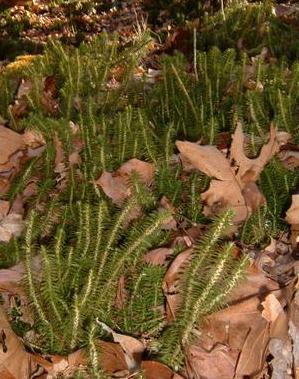
Huperzioideae is a subfamily of lycopsids in the family Lycopodiaceae. It has sometimes been recognized as a separate family, Huperziaceae. The Pteridophyte Phylogeny Group classification of 2016 recognizes three extant genera:

Lycopodium is a genus of clubmosses, also known as ground pines or creeping cedars, in the family Lycopodiaceae. Two very different circumscriptions of the genus are in use. In the Pteridophyte Phylogeny Group classification of 2016, Lycopodium is one of nine genera in the subfamily Lycopodioideae, and has from nine to 15 species. In other classifications, the genus is equivalent to the whole of the subfamily, since it includes all of the other genera. More than 40 species are accepted.

Diphasiastrum is a genus of clubmosses in the plant family Lycopodiaceae. In the Pteridophyte Phylogeny Group classification of 2016, it is placed in the subfamily Lycopodioideae. It is closely related to the genus Lycopodium, and some botanists treat it within a broad view of that genus as a section, Lycopodium sect. Complanata. Some species superficially resemble diminutive gymnosperms and have been given common names such as ground-pine or ground-cedar.

Lycopodiella is a genus in the clubmoss family Lycopodiaceae. The genus members are commonly called bog clubmosses, describing their wetland habitat. The genus has a cosmopolitan distribution, with centers of diversity in the tropical New World and New Guinea. In the past, the genus was often incorporated within the related genus Lycopodium, but was segregated in 1964. In the Pteridophyte Phylogeny Group classification of 2016, Lycopodiella is placed in the subfamily Lycopodielloideae, along with three other genera. In this circumscription, the genus has about 15 species. Other sources use a wider circumscription, in which the genus is equivalent to the Lycopodielloideae of PPG I, in which case about 40 species and hybrids are accepted.
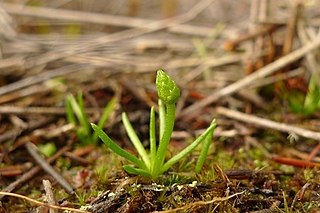
Phylloglossum, a genus in the clubmoss family Lycopodiaceae, is a small plant superficially resembling a tiny grass plant, growing with a rosette of slender leaves 2–5 cm long from an underground bulb-like root. It has a single central stem up to 5 cm tall bearing a spore-producing cone at the apex, and was previously classified variously in the family Lycopodiaceae or in its own family the Phylloglossaceae, but recent genetic evidence demonstrates it is most closely related to the genus Huperzia and is a sister clade to the genus Phlegmariurus, which was formerly included in Huperzia.
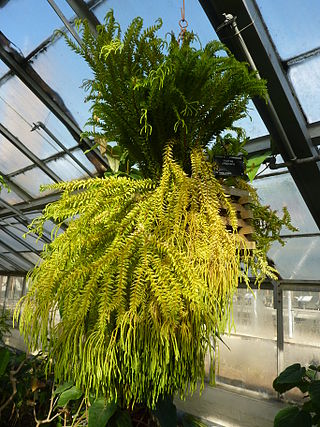
Phlegmariurus phlegmaria, synonym Huperzia phlegmaria, commonly known as either coarse tassel fern or common tassel fern, is an epiphytic species native to rainforests in Madagascar, some islands in the Indian Ocean, Asia, Australasia and many Pacific Islands. Phlegmariurus phlegmaria is commonly found in moist forests and rainforests at high altitudes, in and amongst mosses and other epiphytes. Members of the order Lycopodiales are commonly referred to as clubmosses.

Palhinhaea cernua, synonym Lycopodiella cernua and Lycopodium cernuum, is a plant in the family Lycopodiaceae, commonly known as the staghorn clubmoss. The Hawaiian name for the plant is wāwaeʻiole, or "rat's foot". It has a substantial number of scientific synonyms in several genera. The genus Palhinhaea is accepted in the Pteridophyte Phylogeny Group classification of 2016, but not in other classifications which submerge the genus in Lycopodiella. It is the largest of the clubmosses, having rhizomes up to 5 m (16 ft) in length, with leafy uprights up to 2.5 m in height.

Pseudolycopodiella is a genus of non-seed plants in the Lycopodiaceae, long considered part of Lycopodium, but now recognized as a separate genus. It has 10–14 recognized species, only one in North America: Pseudolycopodiella caroliniana.
The Pteridophyte Phylogeny Group (PPG) is an informal international group of systematic botanists who collaborate to establish a consensus on the classification of pteridophytes that reflects knowledge about plant relationships discovered through phylogenetic studies. In 2016, the group published a classification for extant pteridophytes, termed "PPG I". The paper had 94 authors.
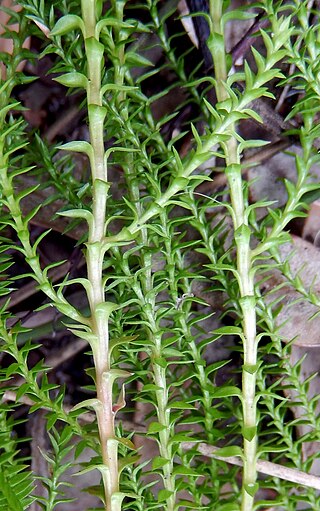
Lateristachys is a genus of lycophytes in the family Lycopodiaceae. In the Pteridophyte Phylogeny Group classification of 2016, it is placed in the subfamily Lycopodielloideae. Some sources do not recognize the genus, sinking it into Lycopodiella. Lateristachys species are native to the Philippines, Australia and New Zealand.

Palhinhaea is a genus of lycophytes in the family Lycopodiaceae. In the Pteridophyte Phylogeny Group classification of 2016, it is placed in the subfamily Lycopodielloideae. Some sources do not recognize the genus, sinking it into Lycopodiella. Palhinhaea species are widespread in the tropics and subtropics.

Austrolycopodium is a genus of lycophytes in the family Lycopodiaceae. In the Pteridophyte Phylogeny Group classification of 2016, it is placed in the subfamily Lycopodioideae. Some sources do not recognize the genus, sinking it into Lycopodium. Austrolycopodium species are mostly native to the temperate southern hemisphere.

Diphasium is a genus of lycophytes in the family Lycopodiaceae. In the Pteridophyte Phylogeny Group classification of 2016, it is placed in the subfamily Lycopodioideae. Some sources do not recognize the genus, sinking it into Lycopodium, others include it in Diphasiastrum. Diphasium species are mostly native to the temperate southern hemisphere, but extend northwards into Central America and the Caribbean.
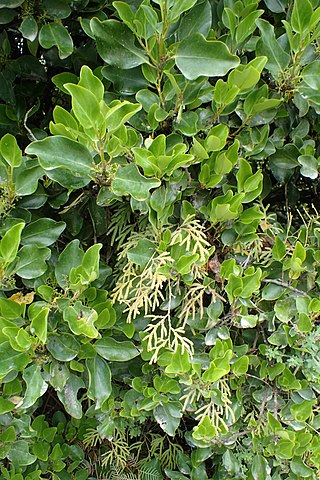
Pseudodiphasium is a genus of lycophyte in the family Lycopodiaceae with only one species, Pseudodiphasium volubile. In the Pteridophyte Phylogeny Group classification of 2016, the genus is placed in the subfamily Lycopodioideae. Some sources do not recognize the genus, sinking it into Lycopodium. Pseudodiphasium volubile is native from Peninsular Malaysia to Queensland, Australia, and has been introduced into Ecuador.
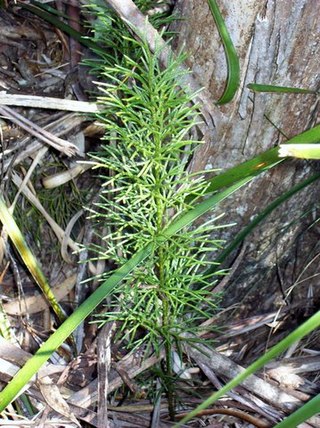
Pseudolycopodium is a genus of lycophyte in the family Lycopodiaceae with only one species, Pseudolycopodium densum, known as the bushy clubmoss. In the Pteridophyte Phylogeny Group classification of 2016, the genus is placed in the subfamily Lycopodioideae. Some sources do not recognize the genus, sinking it into Lycopodium. Pseudolycopodium densum is native to Australia, the North Island of New Zealand and New Caledonia. It is a spore-bearing vascular plant and grows up to a metre high. It is found in a wide variety of situations, often in high rainfall areas on sandy soils.

Lycopodioideae is a subfamily in the family Lycopodiaceae in the Pteridophyte Phylogeny Group classification of 2016. It is equivalent to a broad circumscription of the genus Lycopodium in other classifications. Like all lycophytes, members of the Lycopodioideae reproduce by spores. The oldest fossils of modern members of the subfamily date to the Early Cretaceous.

Lycopodielloideae is a subfamily in the family Lycopodiaceae in the Pteridophyte Phylogeny Group classification of 2016. It is equivalent to a broad circumscription of the genus Lycopodiella in other classifications. Like all lycophytes, members of the Lycopodielloideae are vascular plants that reproduce by spores.
















